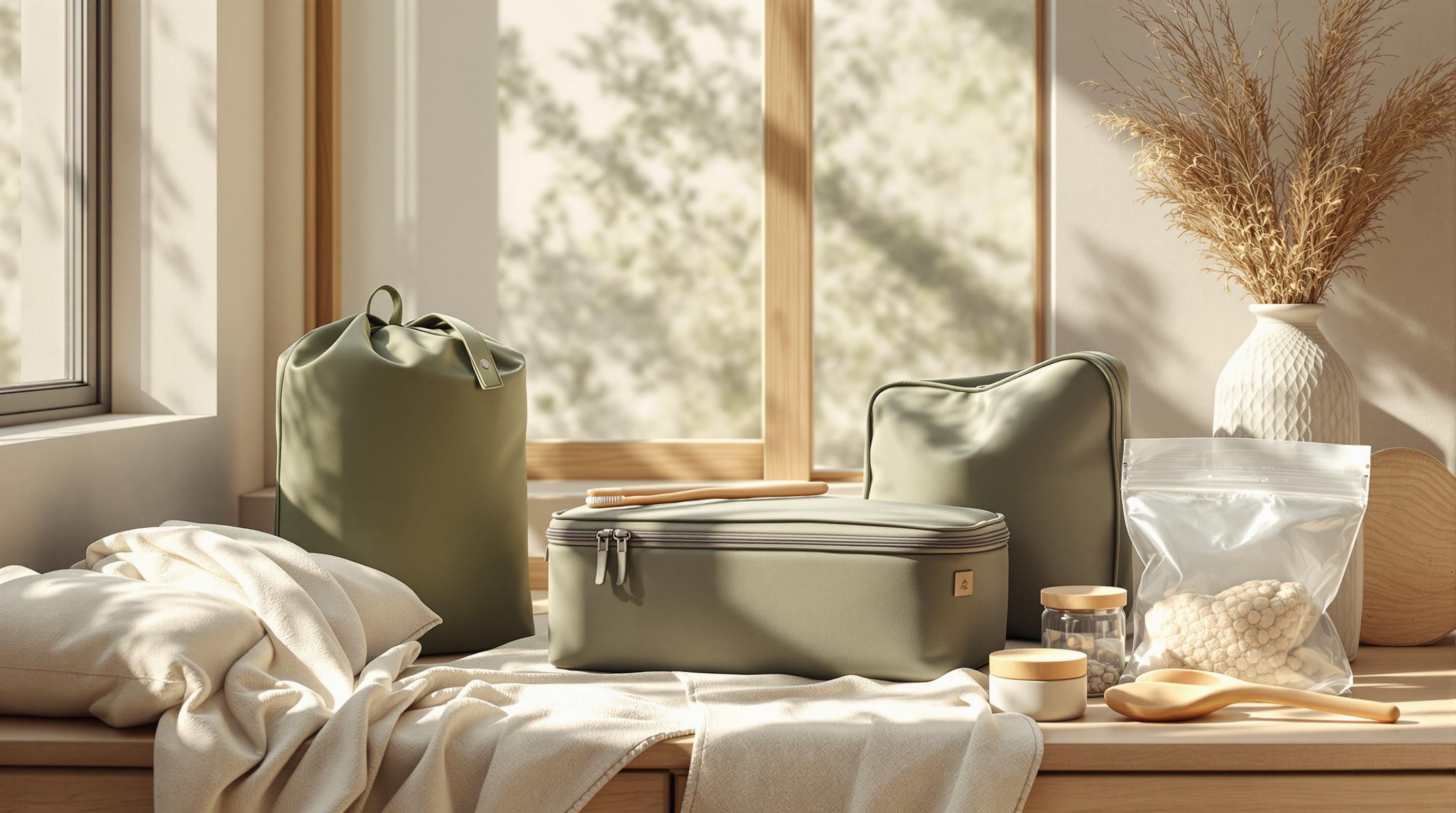Zero-waste packaging is transforming how travel gear is packed, reducing waste while offering practical benefits for travelers. Here’s what you need to know:
- The Problem: Traditional packaging creates excessive waste with hard-to-recycle materials and unnecessary layers.
- The Solution: Zero-waste strategies focus on reusable, space-saving, and custom-fit designs to minimize environmental impact.
- Traveler Benefits: Save space with vacuum compression, reduce waste with durable materials, and enjoy multifunctional packaging like Titantrek’s Atlas Vault backpacks.
Key Features to Look For:
- Durable, reusable materials
- Compression systems to reduce bulk
- Modular, dual-purpose designs
Related video from YouTube
Materials for Zero-Waste Packaging
Selecting the right materials plays a big role in creating zero-waste travel gear packaging. Reusable packaging stands out as a smart choice - it cuts down on single-use waste while keeping your gear safe and organized. Let's dive into the main types and features of reusable packaging that support this eco-conscious approach.
Reusable Packaging Types
Titantrek's vacuum compression system is a standout example, helping reduce bulk and make storage more efficient [1]. Their design offers plenty of storage space along with practical compartments.
Here are some key features that make reusable packaging effective:
- Durable construction: Built to last for multiple uses.
- Flexible design: Works for various needs and situations.
- Space-saving compression: Helps pack more efficiently.
This method fits perfectly with zero-waste goals, giving travelers a reliable and environmentally friendly way to pack.
Custom Packaging Solutions
Custom packaging plays a key role in protecting travel gear while cutting down on waste by eliminating unnecessary materials.
Size Optimization
Getting the right fit starts with accurate measurements. This approach avoids using extra materials and ensures packaging is just the right size. For example, Titantrek's vacuum compression backpacks are designed to meet U.S. carry-on size rules, showing how efficient sizing can make a difference.
- Precise measurements lead to a snug fit and better use of space.
Reducing Empty Space
Compression techniques are an effective way to minimize empty spaces in packaging. By removing air pockets, these methods reduce the need for extra filler, making packaging both more eco-friendly and cost-efficient.
- Smart compression techniques eliminate wasted space.
Cutting Excess Packaging
Using only the materials needed to protect travel gear is key. By removing unnecessary layers, you can reduce material use while still keeping items safe.
- Focus on essential materials for protection.
These strategies set the stage for smarter, more efficient packaging designs.
sbb-itb-b1567d8
Smart Packaging Design
Smart packaging design aims to reduce waste while boosting functionality, especially for travel gear. The goal is to create designs that use fewer resources yet provide more utility. By incorporating multifunctional features, packaging can serve additional purposes, cutting down on waste and its impact.
Mix-and-Match Systems
Modular packaging components are a great way to address sustainability. These systems allow for interchangeable parts that can be tailored to fit specific travel gear. This approach avoids the inefficiency of one-size-fits-all designs. The key is ensuring these components work smoothly together, offering flexibility for different gear sizes and protection requirements.
Space-Saving Designs
Maximizing space is crucial for cutting down on packaging waste. A great example is Titantrek's Atlas Vault backpack, which uses integrated compression to improve packing efficiency [1]. Features like vacuum compression mechanisms help reduce bulk, leading to packaging that’s not only efficient but also multifunctional.
Dual-Purpose Packaging
Smart packaging can do more than just protect - it can offer real utility. For instance, the Atlas Vault includes waterproof construction and specialized compartments, such as a 17" laptop sleeve, enhancing its usefulness [1].
Well-designed dual-purpose packaging should:
- Offer practical use beyond initial protection
- Be durable enough for long-term use
- Work seamlessly with the product it accompanies
This approach not only reduces waste but also provides added convenience for travelers, allowing packaging elements to be repurposed throughout their journey.
Customer Guidelines
Your role is crucial in making zero-waste packaging successful. These guidelines will help you align your actions with the eco-friendly design and material choices mentioned earlier.
Recycling Steps
Recycling responsibly starts with knowing how to handle different packaging materials. When unpacking travel gear, separate materials based on your local recycling rules. Be sure to remove any non-recyclable parts, like adhesive strips or metal fasteners, before recycling the main components.
Here’s how to recycle effectively:
- Clean the materials: Remove dirt and residue.
- Separate materials: Sort paper, cardboard, and plastics into different bins.
- Flatten boxes: Break down cardboard to save space and make processing easier.
- Check local guidelines: Ensure you're following your area's specific recycling rules.
Return Programs
Return programs help create a circular system for reusable packaging. If your travel gear comes with returnable packaging, follow the return instructions provided. Use the included shipping labels to send the packaging back. Many companies now offer perks or rewards for participating in these programs.
Low-Waste Options
Opt for travel gear that minimizes packaging. Look for products that offer:
- Direct shipping: Choose combined shipments to cut down on packaging.
- Digital documentation: Go for electronic manuals and warranties instead of printed ones.
- Custom-fit packaging: Select items with packaging designed to fit the product perfectly.
When shopping for travel gear, prioritize items with streamlined packaging. This not only reduces waste but also makes unpacking and storing easier. Focus on products where the packaging serves multiple purposes rather than relying on excessive, single-use materials. These small choices can significantly contribute to reducing waste.
Next Steps for Zero-Waste Packaging
Tips for Travelers
Opt for long-lasting, reusable travel items to cut down on waste during your trips. These decisions help reduce unnecessary materials and lessen your overall impact on the planet.
While individual actions matter, companies also play a key part in driving these efforts.
Titantrek's Approach to Waste Reduction

Titantrek prioritizes eco-conscious practices by designing packaging that uses fewer materials. This aligns with their mission to offer sustainable travel gear options.

Ultimate Guide to Backpack Weight Distribution
Heat-Resistant Cases for Outdoor Adventures